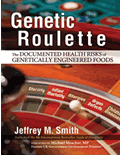Related
Articles:
Cal. County Bans Genetically Modefied Seeds (GMO's)
Hungarians
Protest Agains
GMO Grain
Other
Smith
Articles:
How to Avoid Genetically
Modefied Foods
RICE INDUSTRY: KEEP GENETICALLY ENGINEERED VARIETIES IN THE LAB
By
Jeffrey Smith
October 3, 2006
NewsWithViews.com
The US rice industry can take a lesson from Hawaiian coffee growers. In 2004, the University of Hawaii and others were getting dangerously close to conducting outdoor trials of genetically modified (GM) coffee�plants whose DNA had been artificially inserted with genes from other species. Growers throughout the state knew if their premium coffee became contaminated with GM varieties, it would threaten their markets.
The growers rejected claims that small buffer zones around GM fields would protect them. Bees carry pollen for miles. GM crops can get mixed up by human error. And everyone on the islands knows that seeds naturally travel. (Consider Hawaii�s conversion from lava rock to a lush paradise.)
They extracted a promise from the University to discontinue studies that could lead to outdoor GM coffee trials, saving their farms from contamination. Not so for the rice industry, which just saw world markets close and prices plummet after unapproved GM rice escaped from field trials, contaminating US stocks. Japan stopped buying long grain US rice, products were taken off shelves in Europe and the industry may lose $150 million or more.
Amid the lawsuits and rejected shipments, the rice industry must now decide whether to belatedly follow the coffee growers� example. They can tell the government and five multinational GM crop companies, �No more GM rice trials!� Or they can continue to risk costly episodes of contamination. And for what? To share the fate of soybean and corn growers?
In 1996, biotech companies introduced GM soy and corn varieties that could either withstand herbicide or produce pesticides in every cell. Although the new technology was largely hidden from American shoppers, the European press did extensive coverage and consumers there were not pleased. In a single week in April 1999, food companies throughout the continent responded by vowing to remove GM ingredients from their European brands. Japanese companies followed suit and American agriculture has yet to recover.
The corn industry lost their $300 million European market; US soy sales also plunged. The government poured an extra $2-3 billion per year in price support subsidies. And many non-GM growers were forced to pay for costly segregation programs just to keep their customers. The promise of higher yields, lower chemical use and weed-free living through GM crops turned into slightly lower average yields, significantly higher herbicide use and the emergence of superweeds that resist weed killer. Many who were once enthusiastic about GM technology are saying �Come back in 50 to 100 years when you�ve done your homework.�
The Biotech PR firms want the rice industry and others to believe that gene inserted crops are catching on around the world. In reality, studies show that the more people learn about GM food, the less they want to put it in their mouth. The main reason why most US consumers are complacent is that they don�t know about the issue. Sixty percent say they have never eaten a GM food in their lives. In truth, most eat it everyday�usually in the form of soy and corn derivatives in processed foods.
When Americans find out that they have been eating GM ingredients, they usually assume that the FDA has tested it and proven it safe. Not true. Documents made public from a lawsuit revealed that FDA scientists had repeatedly warned their superiors that GM foods might create unpredictable, hard-to-detect allergies, toxins, new diseases and nutritional problems. They urged political appointees to require long-term safety studies. But the person in charge of FDA policy was the former attorney (and later vice president) of biotech giant Monsanto. And the agency was under orders from the White House to promote GM crops. The policy that was adopted in 1992, and still stands, is that no safety tests whatsoever are required by the FDA. Thus, varieties that had never been rigorously safety tested with animals, and probably never even fed to humans, were approved for sale.
Evidence of adverse reactions is mounting. From the tiny number of safety studies that have been conducted, animals treated with GM crops show stunted growth, impaired immune systems, bleeding stomachs, potentially precancerous cell growth, damaged and misshapen cells, inflamed kidneys, smaller brains and testicles, enlarged intestines, reduced digestive enzymes, higher blood sugar, inflamed lung tissue, increased death rates and higher offspring mortality, to name a few. Reports from the field are less encouraging. Two dozen US farmers say that sterility in pigs or cows is related to GM corn varieties. Seventy-one Indian shepherds report that 25% of their sheep died from grazing on GM cotton plants. Filipinos in at least 5 villages fell sick when nearby GM corn was pollinating. And hundreds of laborers in India developed allergic reactions after handling GM cotton. Soy allergies skyrocketed by 50% in the UK soon after GM soy was introduced. And in the 1980s, a GM food supplement killed about 100 Americans and caused sickness and disability in another 5,000-10,000.
If this information makes you uneasy, consider what will happen when millions of US consumers learn that high-risk GM foods are in their baby�s formula and kids� breakfast cereal. The reaction may force US food manufacturers to repeat the vows of their European counterparts. The corn and soy growers would surely be hit even harder than before.
How will the rice industry fare? That depends on what they choose now. But the choice is not just with rice growers. What about those who deal in lettuce, barley, sunflowers and plums? Most vegetables, fruits and grains have GM counterparts in some stage of development. And behind that variety stands a biotech company, more than willing to grow it field trials and risk the food industry�s markets. Even the US wheat growers remain in danger. They had forced Monsanto to abandon plans to introduce GM wheat in May 2004, but unlike Hawaii�s coffee growers, they can still be contaminated from outdoor field trials.
|
Subscribe to the NewsWithViews Daily News Alerts! |
It
is time that US producers take charge and say to the biotech industry,
�You can grow your GM crops only when we are ready to take that risk.
Until then, keep it in the lab.�
� 2006 Jeffrey M. Smith- All Rights Reserved
Sign Up For Free E-Mail Alerts
E-Mails are used strictly for NWVs alerts, not for sale
Jeffrey M. Smith is working with a team of international scientists to catalog all known health risks of GM foods. He is the author of Seeds of Deception, the world's bestselling book on GM food, and the producer of the video, Hidden Dangers in Kids' Meals.
Website: www.seedsofdeception.com
E:Mail: info@seedsofdeception.com
Soy allergies skyrocketed by 50% in the UK soon after GM soy was introduced.













